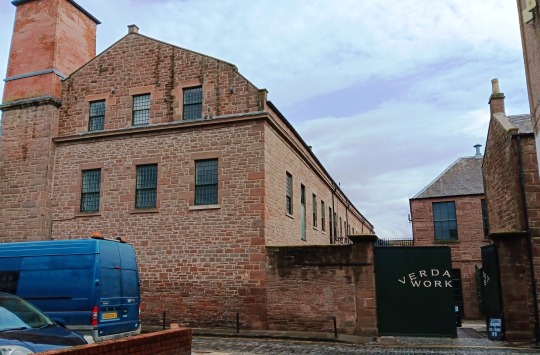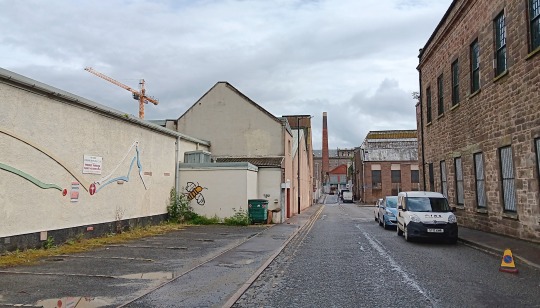#Jute industry
Text
During these moments one needs to follow an effective strategy that is a mix of intuition and effort. When it comes to decision-making, one can learn a lot from Ghanshyam Sarda, the chairman of Sharda Group of Industries.
0 notes
Link
Jute industry plays a vital role in the economy of many countries around the world. It is a natural and eco-friendly fiber that has been used for centuries to make various products such as ropes, bags, carpets, and textiles.
0 notes
Text
Everything about Jute Industry
Everything about Jute Industry
Jute Industry
Q. Why is this in news?
West Bengal is experiencing a crisis that has led to the closure of several Jute Mills.
Q. What is the Issue?
High Rate of Procurement by Mills:Mills are procuring raw jute at prices higher than what they are selling them at after processing.Mills do not acquire their raw material directly from the farmers because:Farmers are far-off from the mills…
View On WordPress
0 notes
Audio
"Dissected Grace" by Jute Gyte - From "Birefringence" (2019)
8 notes
·
View notes
Text
North Sea Scotland (3): Dundee
Warning: This post contains odes to a city's industrial heritage, which some readers may find inappropriate, or just boring.

Our trip so far: we crossed into Scotland, headed straight north to Fife, giving Edinburgh a miss, followed the tourist route along the Firth of Forth and ended up in St Andrews.
The next city up the coast was Dundee.
It has been called the "drug-death capital of Europe" and the "suicide capital of Scotland". We figured Dundee couldn't be that bad and made it our base for a few days.
Our first impressions, however, did little to set the record straight. Below is the view from the place where we stayed.

The next morning, as we set out to explore the city, it began to rain. The museum was the best option.
We found it in this area - the actual building is on the right:

A refurbished 19th-century factory, the museum calls itself "Verdant Works".
The original inhabitants, it must be noted, didn't go in for bucolic appellations. This part of Dundee is named "Blackness" and the brook that runs through it is the "Scouring Burn".
Despite its curious designation, Verdant Works turned out to be a top-notch industrial museum.
Dundee, I learned, grew rich from textiles. In the 16th and 17th centuries local operators began to produce coarse linen from flax – stuff for sacks rather than clothing.
The cottage industry grew in the 18th century, thanks to flax imported from Russia. The government stepped in, on the mercantilist assumption of the time: a key function of the state was to nurture domestic trade and industry.
Thus in Scotland a "Board of Trustees of Fisheries and Manufactures" was created in 1727 to spur flax cultivation. Its "stampmasters" carried out systematic inspections to guarantee quality.
"Dundee's stampmaster David Blair," one panel says, "was known to be particularly vigilant, refusing to pass any adulterated or inadequate cloth."
Another mercantilist measure was the "bounty", an export subsidy that led to soaring linen exports to American in the second half of the 18th century.
But everything is a matter of trade-offs. The downside of government intervention was that manufacturers were stuck with approved fibres. The board "discouraged the use of substitutes for flax in canvas weaving," the museum explains.
From the late 18th century, the idea markets could do fine without bureaucratic encouragement began to take hold (it was a Scot, incidentally, who popularised it in a 1776 best-seller.)
Stamping was abolished in 1823. Mercantilism truly ended when Britain lifted trade restrictions in the 1830s.
Free to experiment and choose suppliers, Dundee's manufacturers found a cheap, excellent raw material for canvas in India. Jute is a taller and easier to harvest than flax. The humid climate where jute grows means the bark rots quickly, making it straightforward to extract the fibre.
By the 1850s, jute overtook flax as Dundee's money spinner. Geopolitics helped. As the museum notes, the Crimean war and the American Civil War created "great demand for tenting, horse blankets, wagon and gun covers, sandbags and for carrying supplies".
But the city’s boom was mostly the result of globalisation.

Strong and porous, jute sacks were ideal for transport and allowed commodities – whether grain, coffee flour, sugar, seeds, coal – to breathe.
Dundee products also moved people: "The emigrants went on to travel across the continents to find land to settle, whilst sheltering beneath jute and linen wagon covers and tents."
Machinery displayed at Verdant Works provides a chance to explore the stages of jute production in fascinating detail.
The processes involved have magical names, such as carding or roving.

Above is a beaming machine. The explanation provided can be arranged as poetry:
"The ends from the swift are taken
Through the top reed
And a tensioning roller
And then tied into the beam."
The emergence of synthetic canvases has not made jute redundant. These days the stuff is used as backing for carpet, lining for shoes, component for roofing, protection for cables.
Jute also makes aprons, mattresses, tarpaulins, conveyor belts, lampshades - and of course sacks and ropes.

Although Dundee developed this most versatile of fabrics and spread it around the world, the city no longer benefits from its enduring appeal.
Today's industry, sensibly, is based where as the plant grows: on the Indian subcontinent. There, the curators say, "the livelihood of millions of people depends on jute production".
So the Industrial Revolution and globalisation may not be a rich-world conspiracy against the wretched of the Earth after all! (Verdant Works is refreshingly free of the guilt-inducing lectures that are rife in modern museums.)
India's jute industry grew over the past 100 years. Many factories were set up by Dundee manufacturers with machines from their redundant works.
After such a wonderfully informative visit, we were curious to get a sense of what the city lives on nowadays. But it was still raining as we walked out. We were faced with this sight:

A short road trip seemed more appealing than a city walk.
0 notes
Photo

Game Room - Beach Style Family Room
Inspiration for a small, enclosed, medium-tone wood floor game room with white walls and a wall-mounted TV in a coastal style.
0 notes
Photo

Game Room Miami
Inspiration for a small coastal enclosed medium tone wood floor game room remodel with white walls, no fireplace and a wall-mounted tv
0 notes
Text
ReshaMandi’s full stack digital ecosystem for natural fibres is empowering farmers, yarn manufacturers, weavers and retailers.
0 notes
Text
The report, "Biodegradable Paper & Plastic Packaging Market by Applications (Food Packaging, Beverage Packaging, Pharmaceuticals Packaging, Personal & Home Care Packaging, and Others), by Packaging Type (Plastic and Paper) and by Geography (North America, Europe, Asia-Pacific, and ROW) - Global Trends & Forecast to 2019" ,defines and segments the global biodegradable packaging market with an analysis and forecast for biodegradable plastic and paper packaging by types, applications, and geography by value as well as volume.
Western Europe and North America are the key markets for biodegradable packaging.
Europe and North America dominated the global pharmaceutical packaging market accounting for more than 65% of the overall market in 2013. Within the North America, the U.S. will remain the largest consumer. Country wise, the U.S. is the top most consumer of biodegradable packaging product globally, and is also the largest market growing at a CAGR lower than the global average till 2019. Member countries of EU, Sweden, Switzerland, U.K., and Germany are the key markets in European biodegradable packaging market and constitute majority of the market size. In terms of growth rate, biodegradable plastic packaging is expected to register a double digit CAGR from 2013 to 2019.
#Biodegradable Plastic Packaging Market#Biodegradable Plastic Packaging Industry#Global Biodegradable Plastic Packaging Market#Polylactic Acid#Starch#Polyhydroxyalkanoates#Polycaprolactone#Polybutylene Succinate#Biodegradable Plastic Packaging#Biodegradable Plastic Packaging Demand#Sales of Biodegradable Plastic Packaging#Paper and Paperboards Biodegradable Packaging Materials#Plastic Biodegradable Packaging Materials Demand#Jute Biodegradable Packaging Material Sales#Wood Biodegradable Packaging Materials#Covid 19 Impact on Biodegradable Plastic Packaging Market#Biodegradable Plastic Packaging Market Share#Biodegradable Plastic Packaging Market Size#Biodegradable Plastic Packaging Sales
1 note
·
View note
Text
The standard legend of India’s Green Revolution centers on two propositions. First, India faced a food crisis, with farms mired in tradition and unable to feed an exploding population; and second, Borlaug’s wheat seeds led to record harvests from 1968 on, replacing import dependence with food self-sufficiency.
Recent research shows that both claims are false.
India was importing wheat in the 1960s because of policy decisions, not overpopulation. After the nation achieved independence in 1947, Prime Minister Jawaharlal Nehru prioritized developing heavy industry. U.S. advisers encouraged this strategy and offered to provide India with surplus grain, which India accepted as cheap food for urban workers.
Meanwhile, the government urged Indian farmers to grow nonfood export crops to earn foreign currency. They switched millions of acres from rice to jute production, and by the mid-1960s India was exporting agricultural products.
Borlaug’s miracle seeds were not inherently more productive than many Indian wheat varieties. Rather, they just responded more effectively to high doses of chemical fertilizer. But while India had abundant manure from its cows, it produced almost no chemical fertilizer. It had to start spending heavily to import and subsidize fertilizer.
India did see a wheat boom after 1967, but there is evidence that this expensive new input-intensive approach was not the main cause. Rather, the Indian government established a new policy of paying higher prices for wheat. Unsurprisingly, Indian farmers planted more wheat and less of other crops.
Once India’s 1965-67 drought ended and the Green Revolution began, wheat production sped up, while production trends in other crops like rice, maize and pulses slowed down. Net food grain production, which was much more crucial than wheat production alone, actually resumed at the same growth rate as before.
But grain production became more erratic, forcing India to resume importing food by the mid-1970s. India also became dramatically more dependent on chemical fertilizer.
According to data from Indian economic and agricultural organizations, on the eve of the Green Revolution in 1965, Indian farmers needed 17 pounds (8 kilograms) of fertilizer to grow an average ton of food. By 1980, it took 96 pounds (44 kilograms). So, India replaced imports of wheat, which were virtually free food aid, with imports of fossil fuel-based fertilizer, paid for with precious international currency.
Today, India remains the world’s second-highest fertilizer importer, spending US$17.3 billion in 2022. Perversely, Green Revolution boosters call this extreme and expensive dependence “self-sufficiency.”
106 notes
·
View notes
Text
Yes, it is critical to acknowledge the centrality of Britain to the world economy in order to understand how Chinese and Indian tea fitted into it. [...] Asian tea relied on forms of employment [...] such as independent family farms in China and indentured ‘coolies’ in India. [...] It would be very difficult to explain how and why Asian tea became driven by the modern dynamics of accumulation then, unless we connect China and India to the broader global division of labor, centered on the most cutting-edge industrial sectors in the north Atlantic. [...] But I also wish to reframe the idea of British capital as “protagonist,” because when we think about capital, agency is a weird thing. [...] Nothing about accumulation is inherently loyal to this or that region, though it has been concentrated in certain sites, such as nineteenth-century Britain or twentieth-century US, and it has been territorialized by nationalist institutions. Thus, although British firms drove the Asian tea trade at first, by the twentieth century Indian and Chinese nationalists alike protested British capital [...].
Most economic histories were focused on whether other countries could ever develop into nineteenth-century England. For labor historians, Mike Davis recently wrote, the “classical proletariat” was the working classes of the North Atlantic from 1838-1921. These modular assumptions jump out when you flip through the classics of Asian economic and labor history, almost always focused on some sort of textile industry (silk, cotton, jute) and in cities such as Shanghai, Osaka, Bombay, Calcutta. By contrast, I was really inspired by a field pioneered by South Asia scholars known as “global labor history” — especially the work of Jairus Banaji — which has been critical of the centrality of urban industry in economic history. Instead, these scholars reconsider labor in light of our current world of late capitalism, including transportation workers, agrarian families, servants, and unfree and coerced labor. These activities have enabled global capitalism to function smoothly for centuries but were overlooked because they did not share the spectacular novelty of the steam-powered factories of urban Europe, US, and Japan.
As far as how tea production worked: in simple terms, Chinese tea was a segmented trade and Indian tea was centralized in plantations known as ‘tea gardens.’ The Chinese trade relied on independent family farms, workshops in market towns, and porters ferrying tea to the coastal ports: Guangzhou (Canton) then later Fuzhou and Shanghai. By contrast, British officials and planters built Indian tea from scratch in Assam, which had not been nearly as commercialized as coastal China or Bengal. They first tried to replicate the ‘natural’ Chinese model of local agriculture and trade, but frustrated British planters ultimately decided to undertake all of the tasks themselves, from clearing the land to packaging the finished leaves. [...] Indian tea was championed as futuristic and mechanized. [...]
In India [...] the tea industry’s penal labor contract became one of the original cause célèbres of the nationalist movement in the 1880s. The plantations later became a site for strikes and hartals, the most famous occurring in the Chargola Valley in 1921. But even though tea workers chanted, “Gandhi Maharaj ki jai” at the time, Gandhi himself had allegedly visited Assam and declined to see the workers, meeting instead with British planters to assure them they were safe. While Indian nationalists had politicized indenture in Assam tea, their main complaint was the racialized split between British capital and Indian labor. Their remedy was not to liquidate the tea gardens but to diversify ownership over them. The cause of labor was subordinated to the nationalist struggle.
---
Words of Andrew B. Liu. As interviewed by Mark Frazier. Transcript published as “Andrew B. Liu - Tea War: A History of Capitalism in China and India.” Published online by India China Institute. 23 March 2020. [Some paragraph breaks and contractions added by me.]
72 notes
·
View notes
Note
🥪💚🧡 for character of your choice!
🥪 SANDWICH — what does your oc's typical lunch look like? do they usually eat lunch?
England eats a simple ham and cheese sandwich for lunch at work, alongside a packet of crisps (Ready Salted or Pickled Onion). He’s not really fussed about lunch entirely - and on work days, England feels as though he’s far too rushed to enjoy it; A satsuma alongside is often viewed as a treat for him on work days, and I think England is very much someone who easily slips into the mindset of efficiency. He usually ends up not bothering with lunch sometimes, making him irritable and tired at times - but at home, England’s far more capable of putting together something more filling; Usually a soup made from one of Scotland’s old recipes when he was younger, or a cheese toastie with worcester sauce. Otherwise, it’s a relatively plain and simple affair for England - in comparison to dinnertimes or breakfast.
💚 GREEN HEART — does your oc prefer being inside or outside?
Well, it depends.
England likes taking long rambling walks through the woods - but he also despises camping outside, much to his brother’s frustration. England loves what inside provides; Showers, Warm Beds and Indoor Heating, but the outside is just as important to him as anything else. It can get uncanny - the notion that the land you walk upon is you - and England wants to look after it well. The Industrial Revolution was a turning point, and his mind slipped from regarding it as infallible - ceaseless, always bountiful - to realising how fragile it can be. When the longbow was used, countless yew trees were chopped to provide wood for the bows and that’s not even mentioning how many oaks were struck down for the Navy’s ships a long time ago. England has seen it all change over time - and while he hates the mud and the prospect of camping, sleeping on the lumpy grass, England finds a sense of peace and quiet outside.
His family is with him, outside too. Not Scotland and Wales, but older family; Those who went before him and perhaps if he focuses enough, waits patiently enough - England can hear the faint whisper of the one that they called Britannia on the vales and in the forests of home.
🧡 ORANGE HEART — does your oc tend to prioritize family or friends?
Family. Always family.
He may have spilled their blood countless times; Might have been a traitor to his own kin, but England loves his family first and foremost. Friends are fleeting and few, but Scotland and Wales were always there. They might not have loved each other all the time - might have struck one another down, and in Wales case - Been struck down, but they are bound together by ties of Earth and Blood and Memory. They remember their childhoods together, and they remember when they were young, fragile and warring; Britons, Celts, Saxons, Angles, Jutes, Norsemen, Roman and Normans - each group trod their Earth and changed their stories bit by bit. England (who resembles his sister so much - almost twins, but not quite) is keenly aware that should anyone have attacked him - who would be next? Wales or Scotland certainly, although England used to harbour grave doubts about them - Particularly towards Scotland, for his relationship with France. Regardless, England knows they’ve all he’s got. They’re stuck together.
Wales taught him how to fire a bow - how to tell stories and how to survive.
Scotland taught him how to swing a sword - how to patch up wounds and how to be strong.
So if it came down to a choice between friends or family, England would choose family.
6 notes
·
View notes
Text


On August 1st 1967 Queen’s College in Dundee became a fully fledged university in its own right and was renamed the University of Dundee.
The history of what would become Dundee University stretches back to 1881 when University College Dundee was founded. Its creation owed much to the wealth gathered in Dundee through the jute and textile industry.
The prospect of establishing a university in Dundee had been under discussion since the 1860s.
It was made a reality with a donation of £120,000 from Miss Mary Ann Baxter, of the hugely wealthy and influential Baxter family. Her cousin, John Boyd Baxter, the Procurator Fiscal for Dundee District of Forfarshire, was heavily involved in the discussions and also donated monies .As the main benefactor and co-founder, Miss Baxter had definite ideas about how she would like the college to run and took an active role in ensuring her wishes were fulfilled.
The deed establishing University College stated that it should promote “the education of persons of both sexes and the study of Science, Literature and the Fine Arts”.
As well as promoting the education of both sexes, Miss Baxter insisted it should not teach Divinity, and was adamant that those associated with the university did not have to reveal their religious leanings.
Her vision of an institution with equality and fairness at its heart has been carried on through the generations.
Amongst the earlier teachers were people of great eminence including D’Arcy Thompson, the biologist who invented mathematical biology and Sir Patrick Geddes, the botanist and town planner.
Of course the notorious poet William Topaz McGonagall , who had a long relationship with Dundee had to put pen to paper and wrote;
Good people of Dundee, your voices raise
And to Miss Baxter give great praise;
Rejoice and sing and dance with glee
Because she has founded a College in Bonnie Dundee
University College, Dundee became part of St Andrews University in 1897, under the provisions of the Universities Scotland Act of 1889. This union served to “give expression to local feeling that there should be a vital connection between the old and the new in academic affairs.”
Initially, the two worked alongside each other in relative harmony. Dundee students were able to graduate in science from St Andrews, despite never having attended any classes in the smaller town.
However, over time relations became strained, particularly over the issue of the Medical School and whether chairs of anatomy and physiology should be established in Dundee, St Andrews or both, setting the stage for the tensions that would place some strain on the relationship between the two institutions in the decades ahead.
By the mid-1900s separation was being proposed.
A 1954 Royal Commission led to University College being given more independence, being renamed Queen’s College, and taking over the Dundee School of Economics.
In 1963, the Committee on Higher Education under the chairmanship of Lord Robbins recommended in its report to Parliament that ‘at least one, and perhaps two, of its proposed new university foundations should be in Scotland’.
The government approved the creation of a university in Dundee, and in 1966, the University Court and the Council of Queen’s College submitted a joint petition to the Privy Council seeking the grant of a Royal Charter to establish Dundee University.
This petition was approved and, in terms of the Charter, Queen’s College became Dundee University on this day in1967.
12 notes
·
View notes
Text
Setting an Example
Drayton Villa in Clara, County Offaly dates from 1849 when built for Lewis Goodbody at the time of his marriage to Rebecca Clibborn. The Goodbodys were a Quaker family who had moved into this part of the country in 1825 and established a number of industries in the town, including a milling business and a jute factory, taking advantage of the river Brosna, The original block was of three bays and…

View On WordPress
2 notes
·
View notes